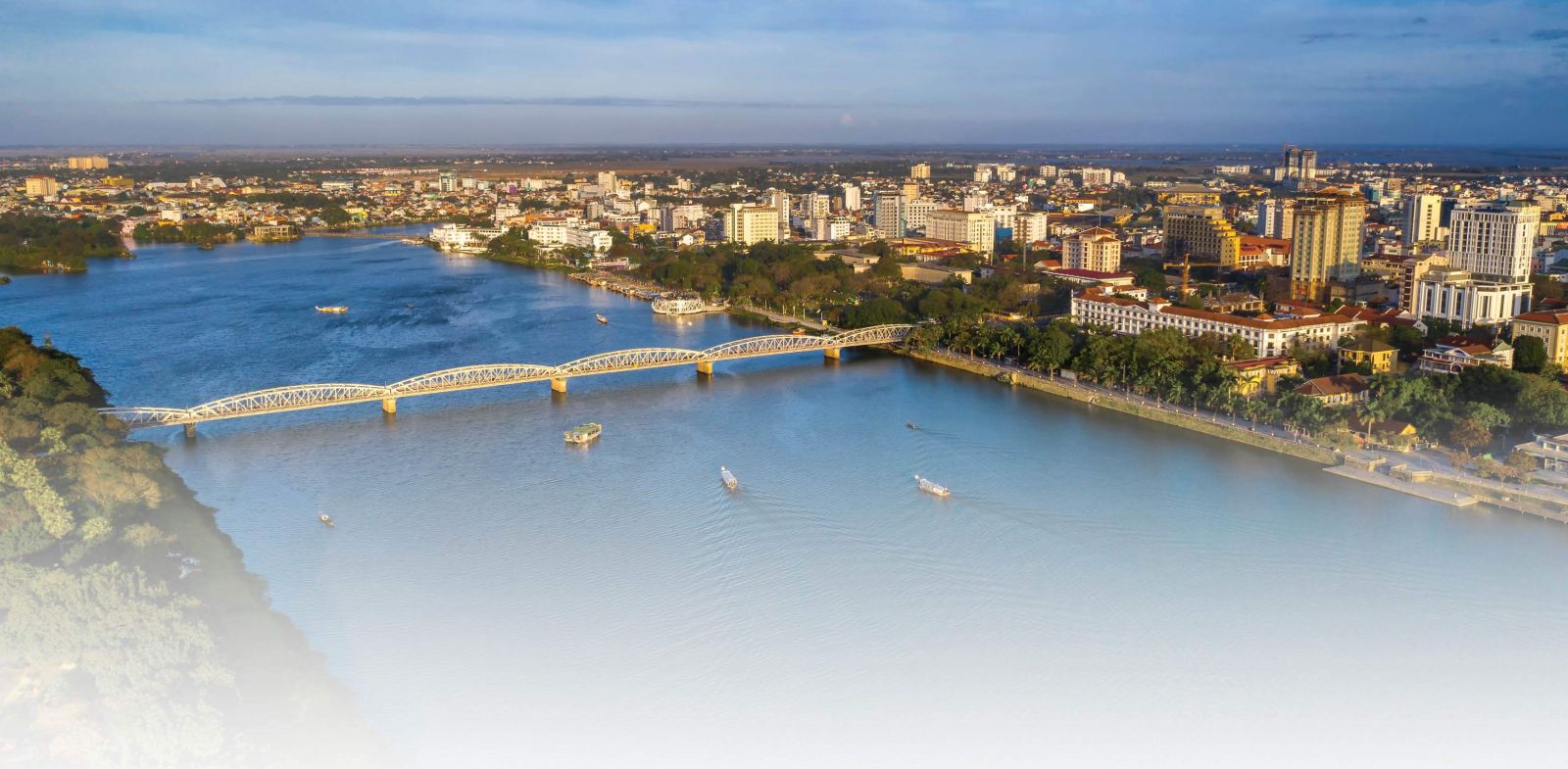
The Huong River divides the south and north banks, creating a characteristic of Hue City
The national-level heritage city
With over two hundred years of establishment and development, Hue is one of the leading localities nationwide in conserving architectural planning and natural heritages. The complex of Hue monuments and famous landscapes and historical sites are well preserved, embellished and protected under pressure of urban development and high-rise buildings.
Hue today is known as not only a national-level heritage city but also a Vietnam’s Festival City and ASEAN’s cultural and tourism city.
The 21th-century future city
Looking back on the process of Hue urban and rural development in the historical process, we can perceive many generations’ inheritance of the thought of conservation and development. They are the respect and protection of the intangible and intangible heritage values of the forefathers and the active building of new heritage areas for the future, bearing the hallmark of the epoch.
Hue Imperial Citadel, the complexes of mausoleums and the ancient urban area on the north bank of the Huong River have borne the hallmark of the 19th-century architectural planning since the Nguyen Dynasty established Hue ancient capital.
The existing central area and the urban area adjacent to the south bank of the Huong River, originally planned by the French and subsequently developed by the successive generations, demonstrate Hue's 20th-century planning and architecture.
Entering the early 21st century, Vietnamese cities flourished after a period of calmness and hardship when peace was restored, of slight disregard for conservation to prioritize development. Meanwhile, Hue identified the appropriate development directions: deliberately increasing the density and height for the south bank of the Huong River, and encouraging the development of modern high-rise buildings in the new urban areas.
In particular, Zone A - An Van Duong New Urban Area - will be a new center of the modern and smart urban identity of the 21st century. As development spreads towards the East, there will be more green space with water surface, ensuring flood drainage corridor towards the East and the sea. It is also a space to conserve historical villages and to build agricultural urban areas and ecological urban areas.
Hue and Da Nang twin cities – the center of Central Region and Central Highlands Key Economic Zone
The idea of forming Twin Cities, Hue - Da Nang, as the central urban core of the Central Region has been raised but forgotten on account of many difficulties. Today, the situation has changed with many big advantages. Hai Van Tunnel has been opened, and the regional cooperation thinking is replacing the regional competitive thinking.
Among the three most important urban areas of the country, despite its considerable potential, the Central Region Key Economic Zone has been behind the remaining two urban areas in terms of scale and socio-economic potentialities.
One of the solutions for increasing the zone position is to increase the position of the central core zone. Building Hue - Da Nang Twin Cities cluster plays a central role in the CRCHKEZ.
A fairly plausible reason is that the two urban zones at both ends of the country have special that play a central role in the zone. And with Da Nang’s unfeasibility of becoming a special city, the birth of the first-class will be the vital prerequisite for the regional development promotion at a new level.
The urban development land fund of Da Nang is limited because most of the land in forests and mountains is not suitable for urban development. Meanwhile, the land fund in the south of Hue bordering Da Nang, especially Chan May and Lang Co, is not only abundant but also strategic.
This will help attract the socialized financial resources and human resources seeking development fortunes in the new lands from Da Nang to Hue, for investment capital is not of regional characteristic but only oriented towards the attractive investment and settlement fortunes. From a regional cooperation perspective, ignoring sectional thinking is a good thing, which helps both localities develop more quickly and sustainably.
In addition, with the geographical features of the Central Region’s narrow zone and the typical topography with the western Truong Son mountain range and the East Sea, the zone's cities should be developed in the linear form. Therefore, a center with two cities will be much better than an extremely big city.
In the world, there have been many successful studies on the planning of twin cities that play a central role of the urban zone such as Minneapolis-Saint Paul, Dallas-Fort Worth, and Champaign-Urbana... Notably, twin cities are not necessarily identical in scale and function. Therefore, while both Da Nang and Hue complement each other in terms of logistics, aviation, marine economy and marine tourism, the former can be financially and industrially stronger, and the latter is stronger in heritage conservation, culture, education and arts.
The first-class city under the Central Government
With the strategic significance, Hue's becoming a first-class city under the Central Government will help Hue to better preserve the national heritage and develop faster. In addition, it will make CRCHKEZ’s central core area and the main gateway to the sea have a worthier scale, which is a precondition for all the provinces and cities in the zone to develop quickly.
Story: Doctor of Science, Architect Ngo Viet Nam Son
Photo: Song Khanh